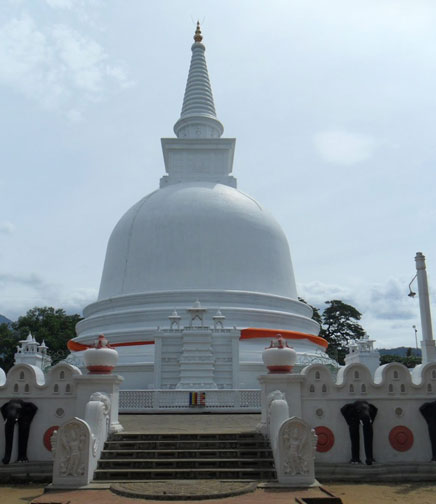|
Musings:
Public demos in 10th century Lanka
by Padma Edirisinghe
Now they call these rallies, Udghoshana. The writer is not aware what
they were called in early times, but the overall features were more or
less the same .The streets were agog with men and women emitting battle
cries such as this, as the 10th century drew to a close carrying with it
the last phase of the Anuradhapura period in the 2,000 plus history of
the island.
|

Mahiyangana chaitya |
*We are hungry
*Reduce taxes
*Poor getting poorer
* Rich getting richer
*Maladministration everywhere
* Corrupt officers deserve punishment
Not all are in the amphitheatre of the public rally. A good many are
spectators among which are a number of females, aahing and oohing over
the raucous gathering.
They are shocked at the histrionic tantrums those enmeshed in the
rally display.
The cacophony created is just unbearable.
Many would attribute the above scene to modern times, and, the places
to the periphery areas of the Colombo city, dotted with slum dwellings
where living is just a nightmare... No. The place belonged to the very
remote areas around Badulla, clothed in luxurious greenery, and the
times belonged to the 10th Century, specifically, to the reign of king
Udaya (935-938 AD) according to Dr. H .A. P. Abeywardena's Lekam miti
Vimarshanaya (Surveys of written records of early times, indeed a grand
work.) He had given it to me years back for a review and now in a mood
of boredom I leafed through it again and came across an account of the
Udgoshana. Only odd characters like me try to conquer boredom by reading
heavy stuff.
For more details of the times, it was the reign preceding the last
reign of the Anuradhapura period, that of king Mahinda. The A'Pura
period itself had come to a tumultuous end reacting to Magha invasion.
The last kings were attempting to pull along the weakened rule. It was
perhaps a part of this attempt that king Udaya set out from Anuradhapura
to consolidate the far off domain of Mahiyangana. He had to pass through
Hopitigamuwa near Badulla, which was a semi urban and rural area
suffering from many an administrative ill and was called a trading town
too. Now, they made use of the king's impending travel to air their
grievances.
Hopitigamuwa, perhaps now gone into oblivion as a separate village,
itself had been a centre of trade, with which the deterioration of the
central kingdom had been subject to much misrule. According to the book,
when the king was passing through, the merchants and denizens of the
town had complained to the king. The main grievances were, that the
original statutes were being violated by bureaucrats, imposing arbitrary
taxes and flouting traditions.
Pandemonium reigned as described above, to show sympathy with the
aggrieved parties.
Insentient to the disturbed politics of the country on the threshold
of a change of capitals from A'pura to Polonnaruwa, the king gave a
sympathetic ear to the complaints, thus granting victory to the
complaining party. Further, the king enacted a set of new rules that
went on to formulate the famous Hopitigamu inscription which was later
shifted to the proximity of the Badulla Kachcheri.
As a result of the rally that created confusion in the local town,
the following laws were laid:
* Taboo on the purchase of liquor, meat and milk from the immediate
dwellers, a practice that had led to much corruption
* No trade on Poya days, which if violated had to be recompensed with
paying oil fines (thel dada) to the Mahiyangana chaitya.
* Trade had to be carried out strictly within the stipulated area.
* All measuring paraphernalia had to be strictly checked and
controlled.
It is interesting to note that these regulations including boundary
divisions were at times translated into folk poetry (JANA Kavi) that
reflect how much in esteem and popularity such regulations were held
among the general public. Verses around the boundaries of Sathara korale,
Galboda korale, Paranakuru korale, Kindigoda korale, Beligal korale and
Harispattuwa have been cited in the chapter on the regulations that were
violated in the 10th century.
|

